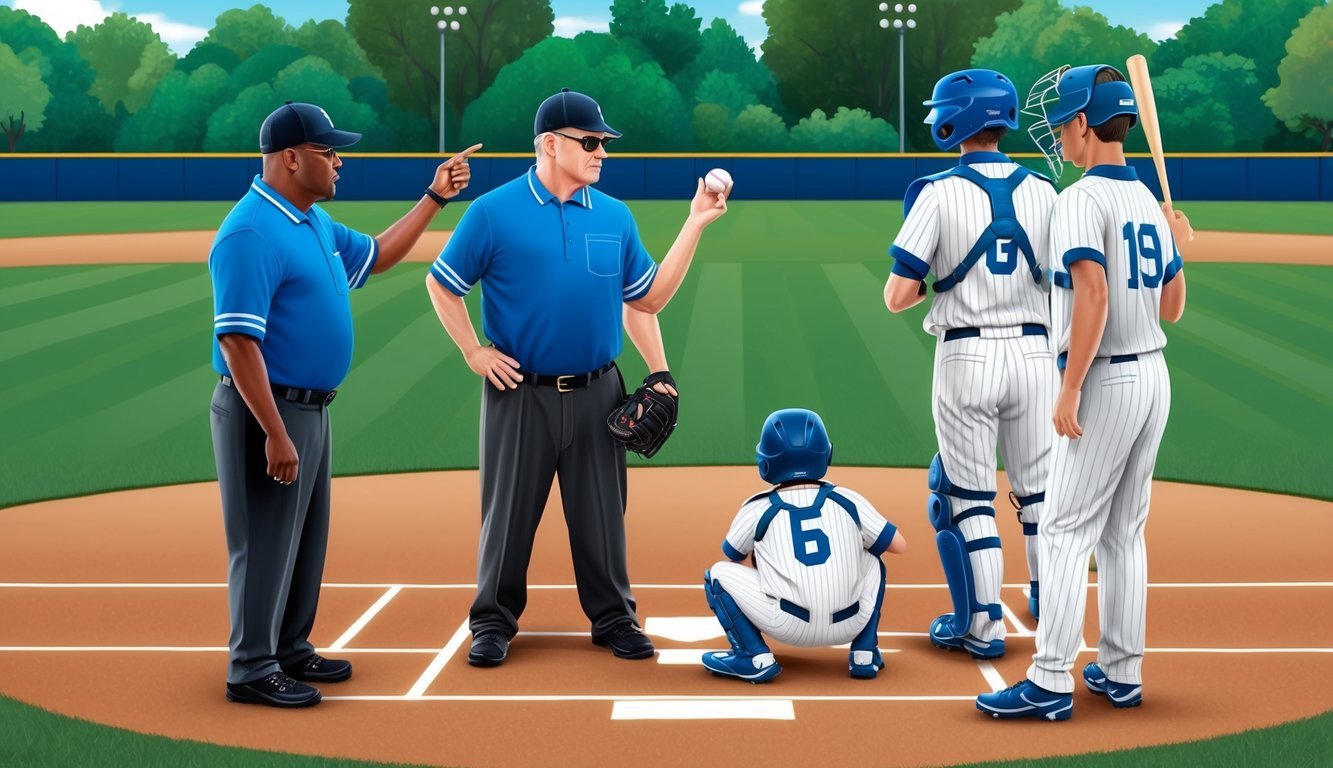Little League baseball introduces children to America’s favorite pastime.
As young players take the mound, it’s crucial to understand the pitching rules designed to protect their developing arms and ensure fair competition. Little League pitching regulations set specific pitch count limits and mandatory rest periods based on a player’s age, with stricter limits for younger pitchers.
These rules aim to prevent overuse injuries and promote proper arm care.
For example, a 12-year-old pitcher may throw up to 85 pitches in a day, while an 11-year-old is limited to 75 pitches.
After reaching certain thresholds, pitchers must observe mandatory rest periods before taking the mound again.
Coaches and parents play a vital role in enforcing these guidelines.
Many leagues now use digital tools like the GameChanger app to accurately track pitch counts and rest days.
By following these rules, Little League ensures young players can enjoy the game safely while developing their skills on the diamond.
Understanding Little League Pitching Rules
Little League pitching rules are designed to protect young arms and ensure fair play.
These regulations cover player eligibility and strict pitch count limits based on age groups.
League Age and Player Eligibility
Little League determines player eligibility using a “league age” system.
This age is calculated based on the player’s age as of August 31 of the current season year.
For regular season play, any player on the team roster may pitch, with some exceptions.
In Minor League, 12-year-olds are not allowed to pitch.
Junior League teams may have additional restrictions.
Some local leagues prohibit 15-year-olds from pitching in the Junior Division.
Pitch Count Limits per Age Group
Little League enforces strict pitch count limits to protect young pitchers’ arms.
These limits vary by age group:
- 13-16 years old: 95 pitches per day
- 11-12 years old: 85 pitches per day
- 9-10 years old: 75 pitches per day
- 7-8 years old: 50 pitches per day
Managers must track pitch counts and remove pitchers when they reach their limit.
Pitchers removed from the mound cannot return to pitch in the same game.
Rest periods are also mandatory.
For example, if a pitcher throws 66 or more pitches in a day, they must rest for four calendar days before pitching again.
Pitching Mechanics and Techniques
Proper pitching mechanics and techniques are crucial for young pitchers in Little League.
They help improve performance and reduce the risk of injury.
Types of Pitches Allowed
Little League pitchers typically focus on mastering a few basic pitches.
The fastball is the foundation, thrown with a four-seam or two-seam grip.
Changeups are also common, helping pitchers disrupt a batter’s timing.
Some advanced players may learn a simple curveball.
Coaches should emphasize pitch accuracy over velocity.
Pitchers can practice different grips and releases to develop their repertoire.
However, complex breaking balls like sliders or knuckleballs are discouraged for young arms.
It’s important for pitchers to vary their pitches to keep batters guessing.
They should work on changing speeds and locations to be effective on the mound.
Proper Pitching Form to Prevent Injury
Correct pitching form is essential to protect young arms from strain and injury.
Pitchers should start with a balanced stance on the rubber.
The windup begins with a smooth leg lift, followed by a controlled stride toward home plate.
As the throwing arm moves forward, proper mechanics ensure maximum velocity and accuracy while reducing stress on the shoulder and elbow.
Incorporating dynamic baseball pitching techniques, such as efficient hip rotation and a strong follow-through, helps develop power and consistency.
By mastering these fundamentals, young pitchers can improve performance while minimizing the risk of injury.
Good mechanics involve:
- Keeping the throwing elbow at or below shoulder height
- Rotating the upper body as the arm comes forward
- Following through completely after release
Coaches should watch for red flags like:
- Dropping the elbow below the shoulder during delivery
- “Flying open” with the front shoulder too soon
- Failing to complete the follow-through
Regular practice of proper form helps build muscle memory.
Pitchers should focus on repeating their delivery consistently.
Rest between outings is crucial to prevent overuse injuries.
Managing Pitchers and Game Dynamics

Little League baseball requires careful management of young pitchers to ensure their safety and development.
Coaches must balance competitive play with protecting players’ arms through proper substitution and rotation.
Catchers also play a crucial role in guiding pitchers during games.
Substitution and Rotation of Pitchers
Coaches need to plan pitcher usage carefully to comply with pitch count rules.
Most Little Leagues cap pitchers at 50-85 pitches per day, depending on age.
Once a pitcher reaches their limit, they must be removed.
It’s wise to have multiple pitchers ready each game.
Coaches should track pitch counts and plan substitutions accordingly.
Some tips for managing rotations:
• Alternate starting pitchers each game
• Use relief pitchers for 1-2 innings at a time
• Give pitchers adequate rest between appearances
• Consider using “openers” for 1-2 innings before bringing in the main pitcher
Proper rotation helps develop more pitchers and prevents overuse of top arms.
It also keeps opposing batters from seeing the same pitcher multiple times.
The Role of the Catcher in Guiding Pitchers
The catcher acts as an on-field coach for pitchers.
A good catcher can:
• Call pitches appropriate for the pitcher’s skill level
• Help pitchers stay calm and focused
• Offer encouragement after tough at-bats
• Alert coaches if the pitcher is struggling or fatigued
Catchers should learn each pitcher’s strengths and pitch selection.
They can guide pitch sequencing to keep batters off-balance.
Communication between pitcher and catcher is key.
Hand signals, mound visits, and non-verbal cues help them stay in sync.
A strong pitcher-catcher bond improves performance and makes games run smoothly.
Rest Requirements and Pitching Limits

Little League baseball has specific rules for pitcher rest and pitch counts to protect young arms.
These guidelines vary based on age groups and the number of pitches thrown.
Mandatory Days of Rest Based on Pitches Thrown
For pitchers aged 14 and under:
- 66+ pitches: 4 calendar days of rest
- 51-65 pitches: 3 calendar days of rest
- 36-50 pitches: 2 calendar days of rest
- 21-35 pitches: 1 calendar day of rest
- 1-20 pitches: No rest required
For pitchers aged 15-16:
- 76+ pitches: 4 calendar days of rest
- 61-75 pitches: 3 calendar days of rest
- 46-60 pitches: 2 calendar days of rest
- 31-45 pitches: 1 calendar day of rest
- 1-30 pitches: No rest required
These rest periods help prevent arm fatigue and injury in young players.
Maximum Pitch Count and Seasonal Limitations
Daily pitch limits vary by age:
- League Age 13-16: 95 pitches per day
- League Age 11-12: 85 pitches per day
- League Age 9-10: 75 pitches per day
- League Age 7-8: 50 pitches per day
If a pitcher reaches their limit while facing a batter, they may finish pitching to that batter.
Some leagues impose additional restrictions:
- Junior League: Local boards may prohibit 15-year-olds from pitching
- Minors/Little League (Majors): Maximum 12 innings per day
Managers should use an ice pack on pitchers’ arms after games to reduce inflammation.
These rules aim to balance competitive play with player safety, ensuring young pitchers can enjoy the game without risking long-term arm damage.
Role of Coaches and Umpires

Coaches and umpires play crucial roles in Little League baseball, especially when it comes to pitching rules.
They work together to ensure fair play, player safety, and adherence to regulations.
Umpire’s Authority on the Field
Umpires are the ultimate decision-makers during Little League games.
They have the power to enforce pitching rules and make calls that affect the game’s outcome.
Umpires closely monitor pitch counts and rest periods for young pitchers.
They can remove a pitcher from the game if they exceed the allowed number of pitches or if they suspect an injury.
Umpires also watch for illegal pitches and balks.
They communicate with coaches about pitching changes and ensure that substitutions are made according to the rules.
Their keen eye helps maintain the integrity of youth baseball and protects the well-being of young athletes.
Coaches’ Strategies in Managing Pitchers
Coaches play a big role in managing their team’s pitchers.
They must balance the desire to win with the need to protect young arms from overuse.
To do this, coaches keep detailed records of pitch counts and rest days for each player.
They also plan pitching rotations carefully, considering upcoming games and tournaments.
Smart coaches teach proper pitching mechanics to reduce injury risk.
They also work on developing multiple pitchers to avoid relying too heavily on one or two players.
During games, coaches must make strategic decisions about when to pull a struggling pitcher or how to navigate tough innings without overtaxing young arms.
Coaches also communicate with parents about their child’s pitching schedule and any concerns.
They play a key role in creating a positive youth sports experience while following Little League pitching rules.
